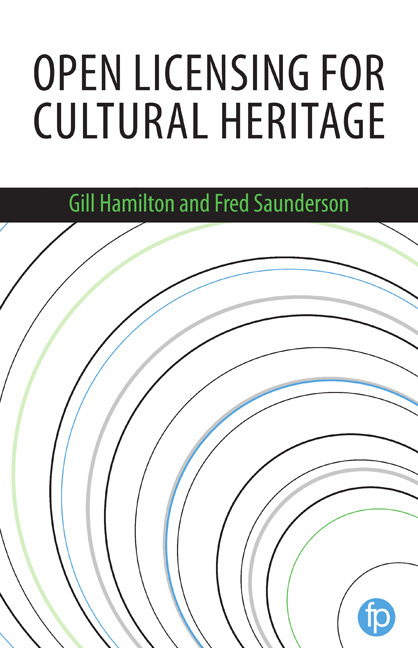Book contents
- Frontmatter
- Contents
- List of figures and tables
- Acknowledgements
- About the authors
- 1 Introduction
- 2 The open movement: its history and development
- 3 Copyright and licensing: a background
- 4 Open licensing: the logical option for cultural heritage
- Introduction to case studies
- 5 Small steps, big impact – how SMK became SMK Open
- 6 The British Library experience of open metadata licensing
- 7 Open policy and collaboration with Wikimedia at the National Library of Wales
- 8 Newcastle Libraries – the public library as a place to share culture
- 9 Developing open licensing at the National Library of Scotland
- 10 The Wellcome Library
- 11 Developing an open educational resources policy and open approaches to mitigate risk at University of Edinburgh
- 12 How to implement open licensing
- 13 Using and reusing openly licensed resources
- 14 Conclusion
- Index
Introduction to case studies
Published online by Cambridge University Press: 08 June 2018
- Frontmatter
- Contents
- List of figures and tables
- Acknowledgements
- About the authors
- 1 Introduction
- 2 The open movement: its history and development
- 3 Copyright and licensing: a background
- 4 Open licensing: the logical option for cultural heritage
- Introduction to case studies
- 5 Small steps, big impact – how SMK became SMK Open
- 6 The British Library experience of open metadata licensing
- 7 Open policy and collaboration with Wikimedia at the National Library of Wales
- 8 Newcastle Libraries – the public library as a place to share culture
- 9 Developing open licensing at the National Library of Scotland
- 10 The Wellcome Library
- 11 Developing an open educational resources policy and open approaches to mitigate risk at University of Edinburgh
- 12 How to implement open licensing
- 13 Using and reusing openly licensed resources
- 14 Conclusion
- Index
Summary
So far, this book has explored the fundamentals of openness and licensing. We have looked at the provenance of the open movement and the realities of the current copyright environment. We have also advanced our arguments for why cultural heritage organisations should adopt an open approach. Before this book turns to the practical details of implementing open licences and using openly licensed material, we will look at a number of contributed case studies.
A range of organisations have undertaken efforts to adopt open approaches. These organisations, from public libraries to national museums, have used open licences to help make openness a viable reality in fields and disciplines as diverse as education, data, art and metadata. This section of the book explores how seven cultural and information organisations – Statens Museum for Kunst (National Gallery of Denmark), the National Library of Wales, the British Library, Newcastle Libraries, the National Library of Scotland, the Wellcome Library and the University of Edinburgh – have developed their approaches to being open and by using open licences have moulded, aided and stabilised these efforts.
These case studies have been contributed by experts and practitioners working within these organisations. Each study brings a distinct voice and experience, and each focuses on a particular aspect of openness and licensing.
We have provided these diverse case studies with the aim of rooting the concept of open licensing in real world experience. We hope that these examples – drawn from distinct fields, varied regions and organisations large and small – will enable practitioners in cultural heritage to further explore the benefits and realities of openness in practice and to gain valuable insight into the steps that others have taken and the lessons learned from early adopters.
- Type
- Chapter
- Information
- Open Licensing for Cultural Heritage , pp. 95 - 96Publisher: FacetPrint publication year: 2017



